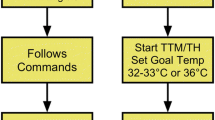Abstract
To clarify the clinical nature of post-resuscitation hyperthermia, we reviewed the charts of 18 patients who had cardiac arrest on arrival and regained cardiovascular stability for a study period of sufficient length. Patients with trauma, burns, poisoning and cerebrovascular accidents were excluded. We analyzed the hyperthermia (above 38°C) occurring in the initial 48 h after resuscitation. After resuscitation, most patients showed a rapid rise in body temperature. Patients with later brain death showed significantly earlier appearance of hyperthermia (6.2 h after cardiac resuscitation; median) and a higher peak temperature (39.8°C; median) compared with patients showing prolonged coma (12.7 h and 38.3°C, respectively). Hyperthermia above 39°C was associated with subsequent brain death. The incidence of factors influencing body temperature did not differ between the brain death and prolonged coma groups. Patients achieving full recovery did not show hyperthermia. In conclusion, hyperthermia is an early indicator of brain damage after resuscitation.
Similar content being viewed by others
References
Clowes GHA Jr, O'Donnell TF Jr (1974) Heat stroke. N Engl J Med 291:564–567
Carlsson C, Hägerdal M, Siesjö BK (1976) The effect of hyperthermia upon oxygen consumption and upon organic phosphates, glycolytic metabolites, citric acid cycle intermediates and associated amino acids in rat cerebral cortex. J Neurochem 26:1001–1006
Gaussorgues P, Gueugniaud P, Vedrinne J, Salord F, Mercatello A, Robert D (1988) Bacteremia following cardiac arrest and cardiopulmonary resuscitation. Intensive Care Med 14:575–577
Calvanese JC, Spohr MH (1982) Hyperthermia from a near hanging. Ann Emerg Med 11:152–155
Mason LJ, Jacobsen WK, Lau CA, Roddy SM, Briggs BA, Hough JM (1985) Temperature instability as an early predictive factor of brain death in paediatric near-drowning victims. Acta Anaesthesiol Belg 36:230–233
Montgomery WH, Donegan J, McIntyre KM (chairpersons) (1986) Standards and guidelines for cardiopulmonary resuscitation (CPR) and emergency cardiac care (ECC). J Am Med Assoc 255:2905–2989
Safar P (1988) Resuscitation from clinical death: pathophysiologic limits and therapeutic potentials. Crit Care Med 16:923–941
Wortsman J, Frank S, Cryer PE (1984) Adrenomedullary response to maximal stress in humans. Am J Med 77:779–784
Boshes B (1969) Syndromes of the diencephalon. In: Vinken PJ, Bruyn GW (ed) Handbook of clinical neurology, vol 2. Localization in clinical neurology. North-Holland, Amsterdam, pp 432–468
Safar P, Cantadore R, Vaagenes P (1984) Prolonged cardiovascular system (CVS) failure after cardiac arrest (CA) and cardiopulmonary resuscitation (CPR) in dogs. Circ Shock 13:70–71
Author information
Authors and Affiliations
Additional information
No financial support was given to this study
Rights and permissions
About this article
Cite this article
Takino, M., Okada, Y. Hyperthermia following cardiopulmonary resuscitation. Intensive Care Med 17, 419–420 (1991). https://doi.org/10.1007/BF01720680
Received:
Accepted:
Issue Date:
DOI: https://doi.org/10.1007/BF01720680




